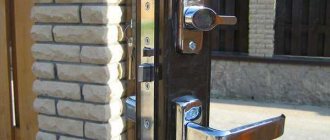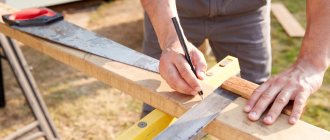Each owner of a personal garden probably has a garden wheelbarrow in his arsenal of equipment, which will help in transporting various construction waste, cleaning the yard during seasonal snowfalls and leaf fall, when planting plants, as well as harvesting crops - in a word, it can handle any kind of household work.
If you don’t already have such a garden assistant, be sure to familiarize yourself with the basic criteria for choosing one and go to the hardware store, armed with this knowledge.
Main selection parameters
So, how to choose a garden wheelbarrow so that it can cope with the tasks the owner needs for many years? First of all, you should pay attention to the following parameters:
Dimensions of equipment, its carrying capacity and weight. The larger the wheelbarrow, the greater the load it can lift, and the heavier its weight. The capacity of a wheelbarrow and its ability to transport a load of a certain weight are calculated not in traditional kilograms, but in liters.
There are models on the market with displacement ranging from 65 to 200 liters. If the owner of a garden plot prefers more spacious equipment, he will have to keep in mind its less maneuverability and greater bulkiness. If you plan to use a wheelbarrow in a relatively small area, you should give preference to garden equipment with a minimum displacement.
The number of wheels on a wheelbarrow. The market today offers both one- and two-wheeled equipment models, as well as four-wheeled options, each of which has pros and cons:
- Single-wheeled garden helpers have excellent maneuverability and fit well into narrow passages, but they are difficult to control - they are quite difficult to roll, they tend to fall to the side and require great physical effort, since under significant loads the wheel rests heavily on soft ground.
- Two-wheeled models, in comparison with the previous version, require more space, have excellent maneuverability and easier control, but their maneuverability leaves much to be desired. The transported and own weight of the wheelbarrow is distributed evenly on the wheels, so it is stable and convenient for loading and unloading operations. This model weighs slightly more.
- Four-wheeled wheelbarrows are characterized by maximum clumsiness, but are well suited where it is necessary to transport large loads, while physical effort is minimal.
Other distinctive features of garden tools that need to be taken into account when choosing relate to its design components, which are worth discussing separately.
What should you pay attention to?
Load capacity
– the main parameter for wheelbarrows and carts. Selected depending on the volume of work. For example, 70-100 kg is enough to transport soil, fertilizers, and garden tools. For building materials – from 100 kg and above.
Body shape
affects the convenience of unloading. Trapezoidal models are easy to empty from bulk and liquid materials: you just need to tilt them forward. Bodies in the form of a parallelepiped are more suitable for boards, tiles, and seedlings. It is more convenient to unload them manually.
Number of wheels
determines maneuverability and maneuverability. One-wheeled wheelbarrows are suitable for hard and flat surfaces, two-, three- and four-wheeled - for loose soil and sand.
Body and body material
– most often plastic or steel. The first models are lighter and cheaper, but are afraid of frost. In winter, they need to be stored in a heated room, otherwise the plastic may crack. The second ones are stronger, they can be used both in summer and winter. To ensure the surface is protected from rust, choose galvanized or powder coated models.
Some models have a battery
. When working with them, you don’t need to apply your own effort - they move on their own, you just need to set the movement.
Which body is most reliable?
If you look at a photo of a garden wheelbarrow made of high-strength steel with a reliable coating, it will be difficult to distinguish it from more affordable analogues with a plastic coating, but meanwhile the body material plays a big role if, for example, you are going to use equipment for transporting minerals fertilizers or any other metal-aggressive loads.
The thickness of the steel directly affects such a parameter as the degree of rigidity of the body, the strengthening of which is important for transporting heavy loads. The steel body is either coated with powder paints to protect against aggressive influences, or galvanized.
Choosing the right body will make it possible to spend less physical effort when transporting cargo. For example, if the leading edge is beveled, up to 70% of the load will be taken by the wheel, greatly reducing the load on the operator. If the body is reinforced with stiffeners, this can prevent its deformation.
Its width is also important, since not every wheelbarrow can fit into the specific space of a garden plot. When choosing a wheelbarrow, take this parameter into account by first measuring the gate opening and other bottlenecks on the site.
Load capacity and weight
The main parameter that shows the maximum weight your car can withstand without breaking is the carrying capacity. This figure varies from 60 to 130 kg.
Do not load the device in excess of the required weight - this will negatively affect the condition of parts and assemblies, and also provoke an early breakdown. If you need increased standards, then you should take a closer look at building samples.
The more weight a cart can support, the heavier it is, since thick metal sheets and pipes have to be used in production. The optimal value is 10 kg.
Please keep in mind that the more massive the structure, the more difficult it is to manage.
What should the frame be like?
The frame also takes on some of the load on the structure as a whole. The more reliable its frame is, the longer the wheelbarrow will last, so it is better that the latter is made from a one-piece, seamless pipe. Seams are acceptable for lightweight equipment options.
Pay attention to the shape of the frame - its bend must be correct. The enclosure should be wrapped in such a way as to create good support below.
Handles are different
When choosing a wheelbarrow, you need to select the length of the handles for yourself - it must be suitable for a specific operator. The space between the handles should be sufficient for comfortable maneuvering of the worker, who can thus reduce the load on the musculoskeletal system. When moving the wheelbarrow, the arms are parallel.
For people with narrow shoulders, comfortable work with wheelbarrows with closed handles is questionable. To make transporting cargo more convenient, you can purchase a wheelbarrow with rubberized lining on the handles, which will not slip during operation.
Step-by-step instruction
We will devote this section to step-by-step instructions for creating a two-wheeled wheelbarrow for the garden with a frame made of metal corners and a profile pipe.
For independent work you will need the following set of materials:
- sheet metal 1 mm thick;
- two wheels;
- a solid, non-hollow blank pipe 20 mm wide for making an axle;
- corners and profile pipes; welding machine;
- Bulgarian;
- tape measure and tap;
- set of bolts and nuts.
First of all, you should take care of creating the axis. We cut it to the required length, and in the end parts we cut out threads for the bolt. Due to it, you can hold the wheels on the front side.
As for the limiter on the inside, we use a washer here. Carefully weld it to the inside of the axle. We seat the wheel on bearings.
To avoid moisture getting inside movable parts, they should be treated with Litol. The movement of the wheels will be soft and fast.
A frame should be welded onto a manufactured pair of wheels for a wheelbarrow, followed by a body. Making a frame is not difficult. We take 32x32 mm corners and cut them into rectangle shapes. The lower form should be smaller than the upper one. It will be possible to secure the parts together using metal jumpers.
The bottom rectangle should be re-strengthened. To do this, we use two flat profile pipes. Due to them, the weight of the entire box is retained, which means the bottom is supported.
The next step in the instructions on how to make a garden wheelbarrow with your own hands involves collecting and welding the handles. It is recommended to make them H-shaped. For correct bending, it is necessary to clearly weld two pipes, then heat them to give the desired look. Then separate and weld to the rear area of the frame.
The next step is welding the axle. Due to a slight shift of its central part back, the front part of the wheelbarrow lowers on its own. This is necessary for easy cargo transportation.
The axial tube is fixed to the corners, which in turn are welded to the surface of the frame. A small stop is attached to the back of the garden wheelbarrow.
The last thing left to do is to cut out the sheet metal pieces and attach them to the frame using a welding machine. If desired, the garden wheelbarrow can be painted in the desired color.
Now you know how to make a wheelbarrow for the garden and what material is best to choose for this. Remember that in the household it is better to use items that are resistant to adverse external factors. In case of high humidity, the material of the cart will remain intact and unharmed.
A little about wheels
According to this parameter, wheelbarrows differ not only in wheel diameter, but also in the type of tire. Tubeless wheel configurations are preferred because if damaged, the punctured area can be vulcanized. If there is a tube under the tire, it is removed. There are also models in which the axle is improved with a bearing, which significantly improves the ride of the garden wheelbarrow.
Vote
What would you choose or recommend?
FIT 77556
4.48 % ( 3 )
FIT Pro 77612
14.93 % ( 10 )
Sibrtech 689633
0.00 % ( 0 )
PRO-110MMU reinforced
19.40 % ( 13 )
AL-KO 100G
1.49 % ( 1 )
ENKI DKT-101 reinforced
14.93 % ( 10 )
Stroymash two-wheeled 320 kg
8.96 % ( 6 )
PRO-2K MU reinforced
13.43 % ( 9 )
ENKI PRO-2k-P reinforced
14.93 % ( 10 )
Garden or construction wheelbarrow?
Both types of house helpers are very similar to each other to the untrained eye, with the only difference being that construction models can lift heavier loads and have an increased volume. Due to this, the walls of their body are thicker, which better protects them from damage.
The selection criterion here is the intended purpose. For work in the garden and yard, it is better to prefer the traditional garden option, while a construction wheelbarrow is useful for purely construction tasks.
Where to begin
First of all, you need to ask yourself the question: “Why do I need a car?”
The question, although simple, is very important. He is the one who will help you decide on the right type of car: Reviews, reviews, but it’s better to hold the “vehicle” in your hands yourself
After this, you can chat with neighbors or friends. Find out what type they use and whether they are satisfied with their purchase. But reviews are reviews, but it’s better to hold it in your hands and try out the “vehicle” yourself. Remember the model you like and study its characteristics in detail. Thus, the choice will be significantly narrowed, and in the store you will not have to get confused by the abundance of modifications and the volume of information heard from the seller.











